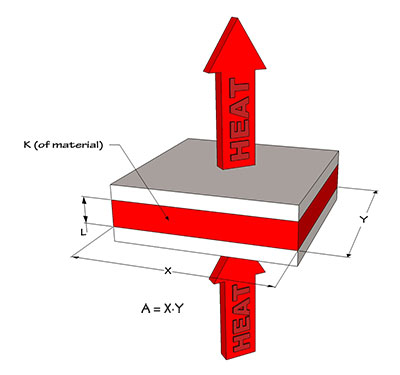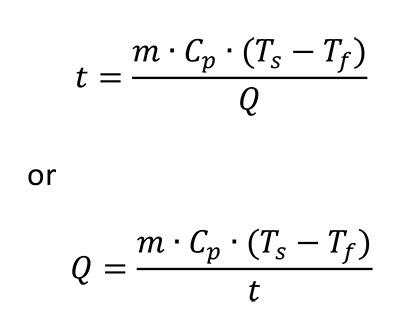Heat Transfer
Thermal Resistance
blurb


R is thermal resistance in C/watt
L is the length in meters (m)
K is the Thermal Conductivity of the material in watts/meter C
A is the cross sectional area in meters squared (m2).
Time Required to Cool (or heat) an Object [or, Q required to cool or heat an object within a specific time]
The following image graphically shows Heating and Cooling as Q (heat) being added or removed from an object.

The following formula is shown in two different ways. The first solves for time t and the second solves for Q.

Where;
Q is the heat added (or being removed) from the object in watts.
m is the mass (weight) of the object in Kg.
Cp is the Specific heat of the object material in J/Kg C.
t is the time required to cool down (or heat up) the object in seconds.
Ts is the starting temperature in C.
Tf is the final temperature in C.
Heat Gain (or loss) - through the walls of an insulated container


Where;
Q is the heat lost or gained in watts
L is the thickness of insulation in meters (m)
K is the Thermal Conductivity of the insulation material in watts/meter K (or C)
A is the outside surface area of the container in meters squared (m2).
h is the Heat Transfer Coefficient of the surface material in watts/meter2 C
Ta is the Outside ambient air temperature in C
TI is the Inside temperature in C
Natural or Free Convection is essentially still to slightly stirred air with h values ranging from 1 to 25.
Forced Convection is air moved by a fan or other active method. h values range from 25 to 100.
Heat Loss (or gain) - by Convection

Where;
Q is the heat lost (or gained) in watts
h is the Heat Transfer Coefficient of the surface material in watts/meter2 C
A is the exposed surface area in meters squared (m2).
Ts is the surface temperature in C
Ta is the ambient air temperature in C
Natural or Free Convection is essentially still to slightly stirred air with h values ranging from 1 to 25.
Forced Convection is air moved by a fan or other active method. h values range from 10 to 100.
Heat is "gained" or added to a surface when the ambient air (Ta) is higher than the surface temperature (Ts).

